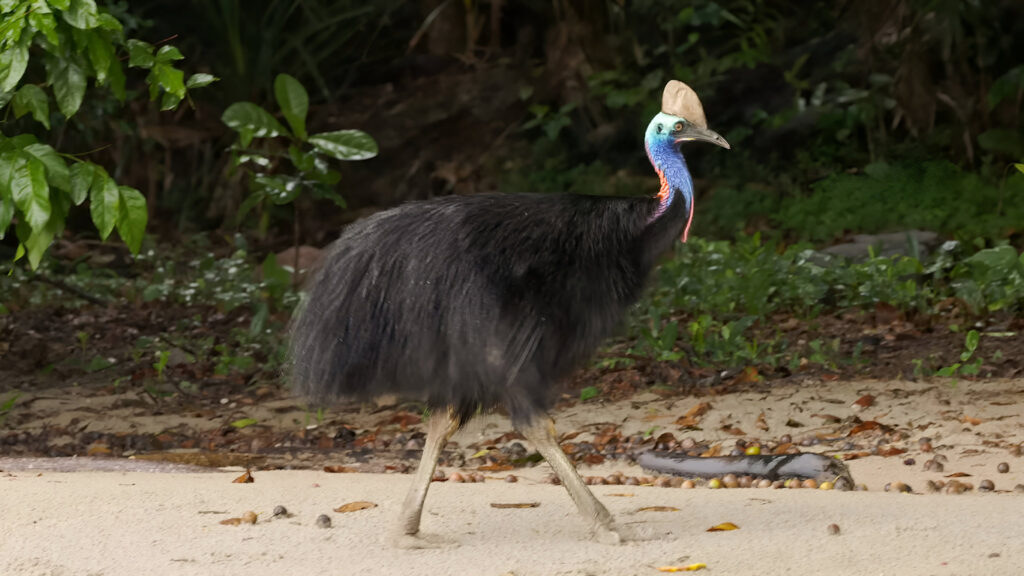1. Cassowaries Are Basically Prehistoric Throwbacks

Cassowaries aren’t your average bird—they’re basically modern-day dinosaurs in a feathered suit. We’re not exaggerating; these birds have existed for millions of years, dating back to the days when actual dinosaurs stomped around. Their scaly legs, sharp claws, and piercing eyes scream “Jurassic Park” without the CGI. At nearly six feet tall and weighing over 130 pounds, cassowaries look like a cross between a velociraptor and a supermodel on a bad day. They even have a helmet-like casque on their heads, giving them the perfect prehistoric accessory. You don’t need a time machine to see a dinosaur; you just need to visit a cassowary’s turf.
2. Their Claws Are Literal Weapons

Cassowaries come armed—and we mean that literally. Each foot has a dagger-like claw on the inner toe, up to five inches long, designed for slashing through underbrush or, if needed, an unlucky predator. These birds don’t just run away from danger; they kick it in the face. People have compared their attack style to that of a velociraptor, and honestly, that’s not hyperbole. There have been documented cases of cassowary attacks on humans and animals, making them officially the world’s most dangerous bird. So, if you see a cassowary fluffing up and lowering its head—start running.
3. They Can Run Like Olympic Sprinters

You’d think a bird that big would waddle, but cassowaries are speed demons. These giant birds can sprint up to 31 miles per hour through dense rainforest terrain like it’s a casual Sunday jog. And if that’s not enough, they’re also excellent jumpers, clearing obstacles over five feet tall without breaking a sweat. Combine that with their razor-sharp claws and prehistoric rage, and you’ve got a bird that could outrun and outfight most animals. If you ever find yourself in a cassowary chase scene, spoiler alert: you’re not winning. They didn’t survive for millions of years by being slow and polite.
4. Cassowaries Are Surprisingly Shy—Until They’re Not

Despite their fearsome reputation, cassowaries are naturally shy and prefer to avoid humans. They’ll quietly stalk through the rainforest, eating fruit and minding their own business. But if you cross their path, especially during breeding season or if they have chicks nearby, all bets are off. They can go from introverted forest dweller to full-blown nightmare in seconds. Many attacks on humans occur because people get too close or try to feed them. So, rule number one in cassowary territory: look, don’t touch.
5. They’re Fruit Fanatics and Ecological Heroes

For all their dangerous vibes, cassowaries are actually rainforest gardeners. Their diet mainly consists of fallen fruit, which they swallow whole—yes, even fruits the size of tennis balls. They have iron stomachs that can handle toxic fruits other animals wouldn’t dare touch. When cassowaries poop, they spread seeds all over the forest floor, helping new plants grow and keeping the ecosystem healthy. So, while they may be terrifying, they’re also vital to their habitat. Think of them as grumpy, sharp-clawed conservationists.
6. Their Casque Is Still a Mystery

That funky helmet on a cassowary’s head isn’t just for show, but scientists still aren’t entirely sure what it’s for. Some believe it helps them push through dense vegetation like a battering ram. Others think it’s a status symbol, with bigger, brighter casques showing dominance. Another theory is that it helps them detect low-frequency sounds in the forest, like a prehistoric satellite dish. Whatever the reason, it definitely adds to their dinosaur-like aesthetic. It’s like the cassowary was designed to look intimidating, and the casque is the cherry on top.
7. They Are Territorial Divas

Cassowaries are not big on sharing—especially when it comes to their turf. Each bird claims a sizable chunk of rainforest as its own and will defend it aggressively. If another cassowary, animal, or (unfortunately) human steps inside that zone, it’s game on. Their dramatic display of fluffing feathers, deep booming calls, and lethal kicks are all about reminding everyone who’s boss. Male cassowaries even get stuck with childcare duty, fiercely protecting their chicks until they’re ready to face the world. Basically, they’re the helicopter parents of the bird world—armed and dangerous.
8. They Communicate Like Dinosaurs

Cassowaries make sounds so low and deep, they’re almost felt more than heard. These booming calls, called “low-frequency rumbles,” can travel long distances through the rainforest underbrush. It’s the closest thing to hearing a real dinosaur call in your lifetime. They use these sounds to establish territory and communicate with potential mates. If you’re hiking and feel a vibration in your chest but can’t see the source—it’s probably a cassowary telling you to back off. It’s their version of “leave me alone,” but in subwoofer mode.
9. They Can Swim Like Pros

On top of everything else, cassowaries are excellent swimmers. They can cross rivers and even swim out to sea if they need to, using their powerful legs to paddle like giant, feathered crocodiles. This skill helps them navigate their rainforest habitats, which often include flooded areas and waterways. So, no, you can’t even escape a cassowary by jumping in the water. They’ll just swim after you like it’s no big deal. Basically, there is no terrain where this bird can’t find you.
10. They’ve Made It Onto Official Danger Lists

Cassowaries are one of the very few birds listed in the Guinness Book of World Records as “Most Dangerous Bird.” Their reputation isn’t based on myth—there have been real, documented fatalities caused by cassowary attacks. Most incidents happen when people get too close or try to feed them, prompting defensive behavior. Wildlife experts consistently warn visitors to stay away from cassowaries in the wild. So, while they might look like fabulous, feathered dinosaurs, they are not here to make friends. Approach them at your own risk—or better yet, don’t approach them at all.


